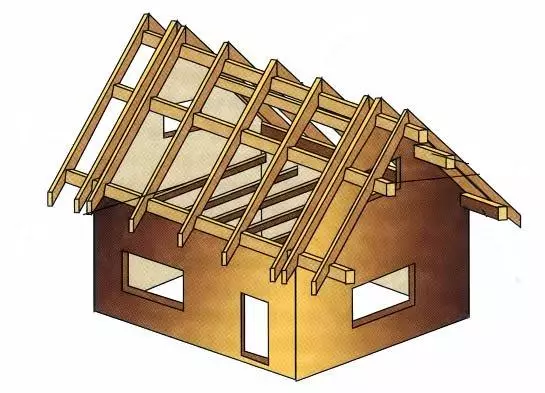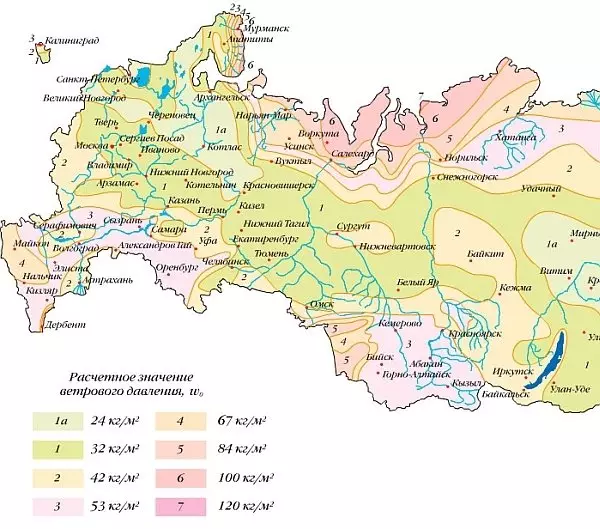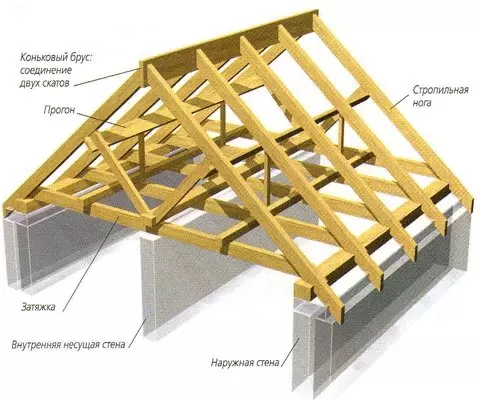Photo
The main carrier roofing elements are urban or hanging rafters. The total weight of the entire load on the roofing system allows them to share them on the types of permanent and temporary (short-term, long and special). The weight of all materials for the construction of the roof should be included in the calculation of the rafter system, therefore it requires its corresponding resistance to long-term loads.

Figure 1. Construction of sprinkled rafters with a support on the walls of the house.
The short-term roof loads include: human weight, special equipment for the service or repair of the roof system. Special types include the effect of seismic activity. The tree for rafters take predominantly coniferous rock, which has passed a special and additional treatment with antiseptics, flame retardant composition.
Continuous loads include the weight of the entire design of the hanging rafters, which turns on:
- Roofing material.
- Slinge system.
- Layer of heat insulation.
- Materials used when finishing the ceilings.
Starting the construction of the roof, it is necessary to pay high attention to what rafters will be used - clogs or hanging. Choosing them, one should compare the shape of the roof with the size of the structure itself and the type of its roof. The roof can have a double or single-line type. This implies the use of rafters with different ways of mounts when mounting.
Rafters and their installation
Proper installation of revolving rafters

Figure 2. Snow load card.
In buildings having a single-table or double-type roof type, utility rafters are used. This type of elements is the structure of small sizes or bars, for which two walls of the structure are supporting, or three points that include a hat with two walls.
The skiing element, that is, the timber, is strengthened with the help of racks based in the litter. The use of certain options after the built house has the necessary overall dimensions, that is, more than 6 meters, is associated with the appearance of the need for the construction of walls or supports.
Article on the topic: Differences of plastic windows
The most ends of the design of the spots of the rafter are the walls of the house, and the average design level should be based on additional reference elements (racks, beams, various runs, etc.), which are intermediate. This is shown in Fig. 1. Accordingly, they can be installed in buildings equipped with columnar supports by either the average level of bearing walls.
The sling type is set at a distance from one type of support to another no more than 6.5 meters. The presence of additional supporting elements can allow the width of large sizes, which should be covered with the help of springs, whose size is up to 12 meters. Sometimes the opening overlap with two adjacent supports on a width of no more than 15 m.
In buildings from a bar, the top crowns made of wood are provided from the timber. The support of the skeleton legs is the top strapping. If the width of the construction is everywhere the same, then the roof with a spatial view of the rafter comes out with the smallest weight. Instead of ordinary wood structures, the use of iron forms and beams is predominant.
If the roofing rafting system has rafters that create the conditions of normal pressure on the wall, which is horizontal and cutting, then at the same time the name of the rafter feet will be faded sprinkling rafters. Mount them are permissible three ways that exclude the possibility of unsafe level of loads on the walls:

Figure 3. Calculated snow load.
- The rafter foot when mounting is stitched by Bru, it can sometimes be resting in the end of Mauerlat himself, it is required to strengthen it by writing.
- Due to the moving connection, namely the slider, the rafters are attached to the bars or Mauerlat, the laying of the upper ends of the rafter is fixed with nails.
- This method matters for hard-type rigid type and rafters, which is used for skate nodes. The boards should be knitted with nails in parallel direction of the skate bruster of each side.
Mount the sleeve rafters spacers - it means to arrange roofing systems, the pressure level on the system will be transmitted to the walls (if rafters are attached to them).
Article on the topic: Sky on the ceiling do it yourself
If you take into account all three possible methods for fastening the fastening types of rafters, changing the mounting rafted on a rigid, still connecting them with bars or by Mauerlat, then you can achieve the internal voltage in a system expressed in the operating type of pressure on the walls.
In fact, the spacer types of sprinkled rafters are a transitional scheme in the conditions of installation of faithful rafters of a utility type to hanging elements.
How to carry out load calculations on the roofing line system
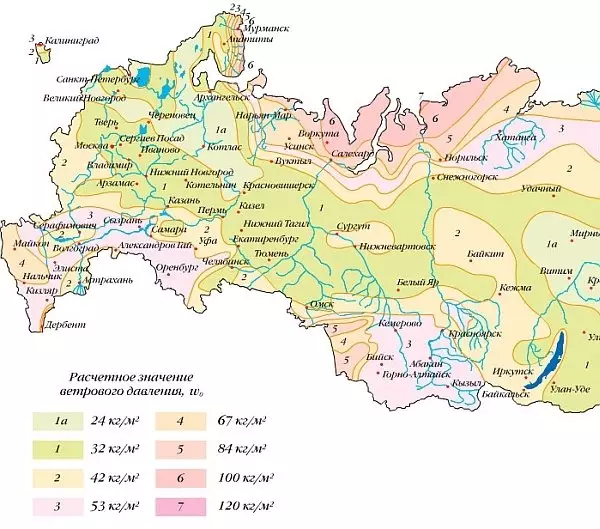
Figure 4. Wind Load Card.
Calculations of various wind load indicators are associated with a certain type of terrain. To make the calculation of snow or wind loads, you can use formulas (1) and (2):
S = SG * μ in (1),
where SG is an indicator for calculating the weight of the snow cover on the meter square horizontal surface of the land plot, which should be taken into account in accordance with the table (Fig. 2). Table values from i to VIII correspond to areas indicated on the map of snow loads by region. The scheme for calculating the table is shown in Fig. 3.
μ is a coefficient pointing to the transition from the total weight of the entire cover of snow on the ground to the snow load on the coating.
The coefficient μ is determined by the angle of inclination of the roof of the roof:
- μ = 1 if the angle of slope
- μ = 0.7 if the angle of the slope is in the range of 25-60 °;
- If the angles of the inclination of the roof is over 60 °, then the level of the coefficient μ under conditions of complete calculation of the value of the snow load is not taken into account.

Figure 5. The values of the correction coefficient, which depends on the height of the structure and the type of terrain.
W = wo * k (2),
where Wo is an indicator of the normative values of wind loads, taken into account in the formula on table data for the calculation (Fig. 4);
k is a coefficient depending on the conditions of the terrain, takes into account the change in wind pressure in height, it is determined, given the table values (Fig. 5). The letter "A" in the table means the presence of open coasts of different reservoirs, deserts, tundra, forest-steppe or steppes. Under the "B" means the presence of urban area, a forest array or other terrain, having irregularities or barriers more than 10 m height.
Article on the topic: Why does the washing machine take the washing powder or air conditioning and what to do?
Hanging rafters: how to install
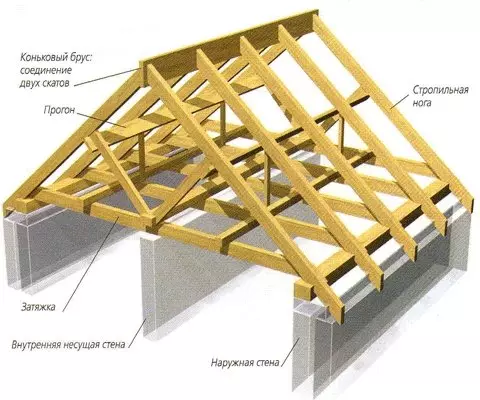
Figure 6. The device hanging rafters with a support on the walls of the house.
For overlapping various spans, which reach more than 7 m in length, in most cases hanging rafters, shown in Fig. 6. Their device is associated with the adoption of the wall per support point. A special tightening is used, which prevents the design of the rafting legs to drive around.
According to its operational properties, the hanging rafter system is based on possible compression and bends. At the same time, the system has operating abilities transmitting walls. In order to reduce these efforts, tightening (steel or from wood) are used, which connect the rafting legs. They can be placed at the base of the construction of the rafting system and higher it.
The higher the fastening of a special tightening, the greater reliability should have hanging rafters.
In the flights that make up more than 8 m, the beam (rack), having a scroll, can be used. The advantages of this roofing system include the ability to overlap large lumen.
Hanging rafting systems are used for buildings that have a lightweight wall design. In the device of a rafter of a hanging type, they usually can be leaked to their ends in the construction of the wall of the building, as well as Maurylalat, which is a support form of a bar. The support structures of the intermediate type are not provided.
The solry system is fixed by clamps to the walls of the structure. There is a spacel voltage that is not transmitted on the walls, but remains in the established limits of the triangle shape, which includes a tightening and both elements of hanging rafters. The tightening must be reinforced on Mauerlat. At the same time, rafters with tightening are not based on the design of the walls, but on Mauerlat.
When installing hanging rafters, it is used. So the rafter fasten to Mauerlat, fixing it with bolts or nails. The suspension device has been completed when they are connected in a skate and are strengthened with wooden lining.
